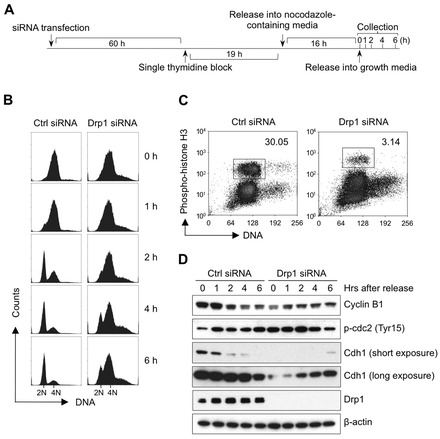Fig. 3.

The G2/M cell cycle arrest observed in Drp1-deficient cells is not caused by disruptions in the molecular machinery that is essential for the G2/M cell cycle transition. (A) The schematic indicates the thymidine/nocodazole block protocol used to synchronize siRNA-transfected cells in the G2/M phase. (B) Loss of Drp1 prevents cell cycle progression after the release from the G2/M block. Control cells and Drp1-deficient cells were released from a thymidine/nocodazole block and cell cycle distribution was determined by flow cytometric analysis of propidium iodide stained cells collected at the indicated time points (right). (C) Loss of Drp1 decreases the number of cells in mitosis immediately after the thymidine/nocodazole block. Control cells and Drp1-deficient cells were synchronized and cells expressing phospho-histone H3 were labeled by using Alex Fluor 647-conjugated anti-phospho-histone H3 antibody and detected by flow cytometry. (D) Loss of Drp1 suppresses the factors that are essential for mitotic entry. Control cells and Drp1-deficient cells were synchronized and collected at the indicated time points after release. The changes in the proteins that are associated with mitotic entry were analyzed by western blot. These data represent three independent experiments.
